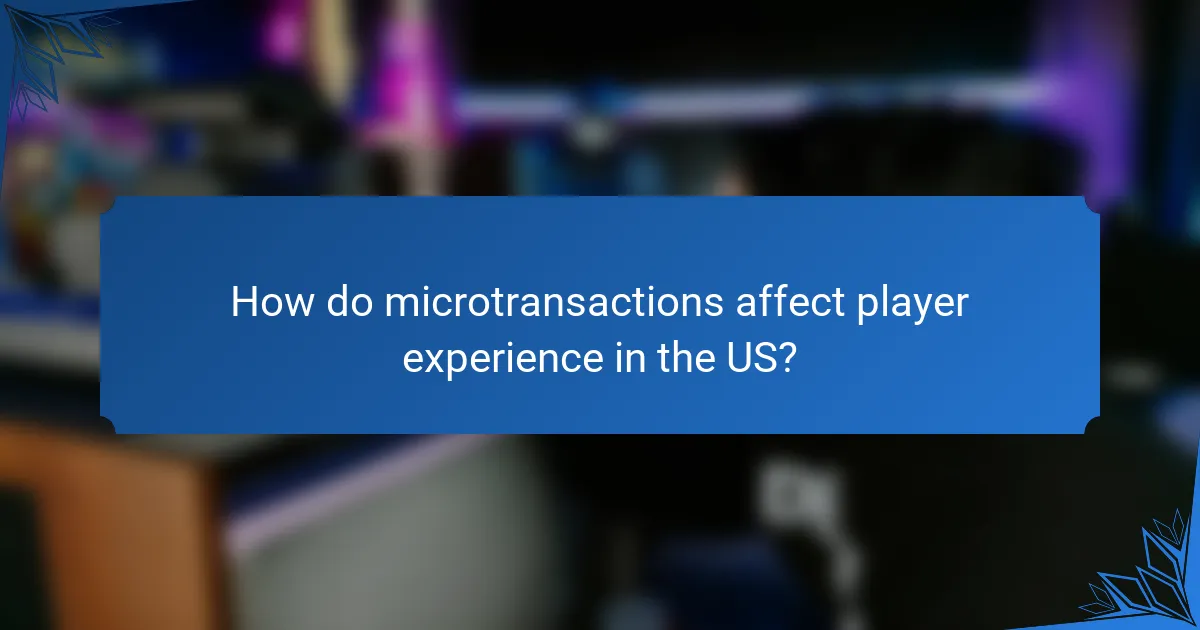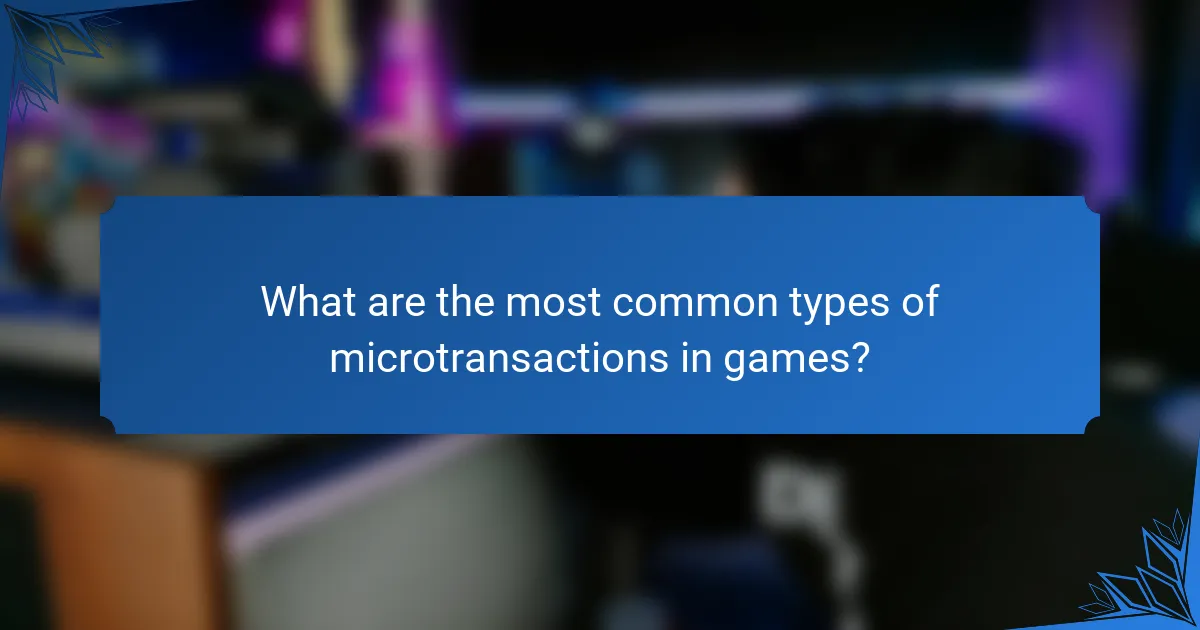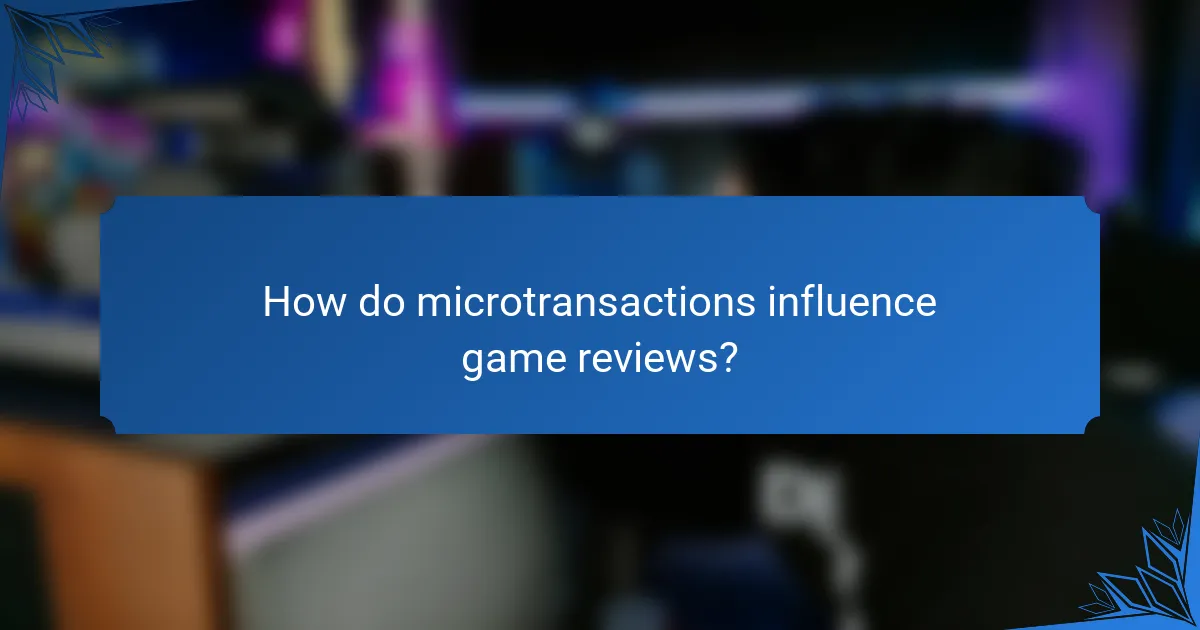Microtransactions have become a pivotal aspect of modern gaming, influencing player experiences and shaping game reviews. While they can enhance engagement through additional content and rewards, they may also introduce frustrations, particularly when paywalls obstruct gameplay. The way these transactions are implemented can significantly affect player perceptions of value and fairness, ultimately impacting a game’s reception among critics and players alike.

How do microtransactions affect player experience in the US?
Microtransactions can significantly shape player experience in the US by introducing both challenges and opportunities. While they may enhance engagement through rewards, they can also lead to frustration due to paywalls that hinder gameplay.
Increased frustration due to paywalls
Many players experience frustration when encountering paywalls that restrict access to content unless they make additional purchases. This can create a sense of inequity, especially in competitive games where players who spend money gain advantages over those who do not.
For example, a player may find themselves unable to progress in a game without purchasing a new character or upgrade, leading to dissatisfaction and potential abandonment of the game. This frustration can negatively impact overall enjoyment and lead to critical reviews.
Enhanced engagement through rewards
On the positive side, microtransactions can enhance player engagement by offering rewards that motivate continued play. Players may be incentivized to spend money on cosmetic items or in-game currency that enrich their gaming experience without affecting core gameplay.
For instance, limited-time offers or exclusive content can create excitement and encourage players to participate more actively in the game. This can foster a sense of community as players share their experiences and achievements related to these purchases.
Impact on game immersion
Microtransactions can also affect game immersion, either positively or negatively. When implemented thoughtfully, they can enhance the narrative or world-building aspects of a game, allowing players to customize their experience and feel more connected to the game environment.
Conversely, intrusive microtransactions can break immersion, especially if they interrupt gameplay with prompts to purchase items. This can detract from the storytelling experience and lead to a disconnect between the player and the game world.

What are the most common types of microtransactions in games?
The most common types of microtransactions in games include cosmetic items, in-game currency, and season passes. These transactions allow players to enhance their gaming experience, often by purchasing additional content or features that do not affect gameplay balance.
Cosmetic items
Cosmetic items are non-essential purchases that alter the appearance of characters, weapons, or environments without impacting gameplay. Examples include skins, outfits, and emotes. Players often enjoy customizing their avatars, which can enhance personal expression and engagement within the game.
While cosmetic items can be appealing, it’s important to consider their pricing. Many games offer these items at various price points, typically ranging from a few dollars to upwards of twenty dollars for exclusive or limited-edition content. Players should evaluate whether the investment aligns with their enjoyment of the game.
In-game currency
In-game currency allows players to buy items or upgrades within the game, often through microtransactions. This currency can be earned through gameplay or purchased with real money, creating a dual economy. Players should be cautious, as spending on currency can lead to significant expenses over time.
Common types of in-game currency include gems, coins, or tokens, which can vary widely in cost. For instance, players might spend around $5 for a small bundle or $50 for a larger pack. It’s advisable to set a budget to avoid overspending, especially in games that encourage frequent purchases.
Season passes
Season passes provide players with access to a series of content updates, challenges, or rewards over a specific period. These passes typically cost between $10 to $50 and can offer significant value if players are committed to the game. They often include exclusive items, early access to new content, or bonus challenges.
When considering a season pass, players should assess their interest in the game’s ongoing content and whether they will actively participate throughout the season. It’s wise to check reviews or community feedback on the value of previous passes to make an informed decision.

How do microtransactions influence game reviews?
Microtransactions significantly impact game reviews by shaping player perceptions of value and fairness. Games that implement these transactions poorly often receive negative feedback, while those that integrate them thoughtfully can enhance player satisfaction and garner positive reviews.
Negative reviews due to aggressive monetization
Many games face criticism when microtransactions are perceived as aggressive or exploitative. This includes practices like pay-to-win mechanics, where players can gain significant advantages through purchases, leading to frustration among those who prefer skill-based competition.
Examples of negative reviews often highlight instances where players feel pressured to spend money to enjoy the game fully. Such feedback can lead to lower ratings on platforms like Steam or Metacritic, as players express their dissatisfaction with the monetization model.
Positive reviews for fair implementation
Conversely, games that adopt a fair approach to microtransactions can receive favorable reviews. When players feel that purchases are optional and do not hinder gameplay, they are more likely to appreciate the game. Cosmetic items or expansions that enhance the experience without affecting balance often receive praise.
For instance, titles that offer cosmetic upgrades or additional content at reasonable prices tend to foster goodwill among players. This positive reception can translate into higher ratings and increased player retention, as users feel respected and valued by the developers.

What are the psychological effects of microtransactions on players?
The psychological effects of microtransactions on players include increased feelings of urgency and a tendency toward compulsive spending. These effects can significantly alter how players engage with games, often prioritizing monetary investment over gameplay enjoyment.
Encouragement of compulsive spending
Microtransactions can create a cycle of compulsive spending, where players feel compelled to make frequent purchases to enhance their gaming experience. This is often driven by limited-time offers or exclusive content, which can trigger a fear of missing out (FOMO).
Many players may find themselves spending more than they initially intended, as the incremental nature of microtransactions makes it easy to justify small purchases. Over time, these small amounts can add up to significant expenditures, leading to potential financial strain.
Altered perceptions of value
Microtransactions can distort players’ perceptions of value, making them more likely to equate spending money with gaining advantages or status within a game. This shift can lead to a diminished appreciation for the game’s core content, as players may prioritize paid features over free gameplay.
For example, players might perceive a cosmetic item purchased for a few dollars as more valuable than hours spent earning in-game rewards. This change in perception can undermine the satisfaction derived from traditional gameplay, leading to a less fulfilling gaming experience overall.

How can developers balance microtransactions and player satisfaction?
Developers can balance microtransactions and player satisfaction by implementing fair pricing models and actively seeking player feedback. This approach ensures that monetization strategies do not detract from the overall gaming experience.
Implement fair pricing models
Fair pricing models are crucial for maintaining player trust and satisfaction. Developers should consider offering a range of microtransaction options, from low-cost items to more expensive bundles, allowing players to choose what fits their budget. For example, cosmetic items could be priced between $1 to $10, while larger content packs might range from $10 to $30.
Transparency in pricing is also vital. Clearly communicating what players receive for their money can help mitigate feelings of exploitation. Avoid hidden fees or overly aggressive upselling tactics, as these can lead to negative player experiences and reviews.
Focus on player feedback
Actively soliciting and incorporating player feedback can significantly enhance the balance between microtransactions and satisfaction. Developers should create channels for players to express their opinions, such as surveys or community forums. Regularly reviewing this feedback can help identify areas where microtransactions may be perceived as unfair or intrusive.
Additionally, developers should be willing to adjust their strategies based on player input. For instance, if players express dissatisfaction with the pricing of certain items, consider revising those prices or offering discounts during special events. This responsiveness can foster a positive community and improve overall game reviews.

What are the regulatory considerations for microtransactions in gaming?
Regulatory considerations for microtransactions in gaming focus on consumer protection, transparency, and fair play. These regulations aim to prevent exploitative practices, especially concerning minors and vulnerable players.
Legislation in the European Union
In the European Union, regulations surrounding microtransactions have become increasingly stringent. The EU has implemented directives that require game developers to disclose the presence of microtransactions and their potential impact on gameplay, particularly in games targeting younger audiences.
One significant regulation is the requirement for clear labeling of games that include loot boxes, which are often categorized as gambling-like mechanics. This labeling helps inform players about the risks associated with spending real money on virtual items.
Additionally, the EU is exploring further regulations that may impose stricter controls on how microtransactions are presented and marketed, ensuring that consumers are not misled or pressured into making purchases. Developers should stay updated on these evolving regulations to ensure compliance and avoid penalties.



